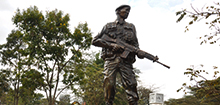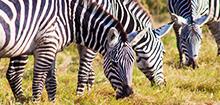Date Published:
Carcasses of three black Rhinos were reported between 12th to 19th November, 2018 at the Mara Triangle, which is the north-western part of the Maasai Mara National Reserve managed by The Mara Conservancy on behalf of the Narok County.
KWS provides an oversight role and technical support in the management of wildlife in the reserve.
Rangers from the Mara Triangle sighted the carcases while on routine patrol in the expansive wildlife reserve. On November 12, 2018, they identified carcass belonging to a male rhino christened ‘Sairowua’. It was among the oldest rhinos in the conservancy and had been observed to be in good health a few days earlier.
Kenya Wildlife Service (KWS) mobile veterinary unit was called in and requested to do a post-mortem to establish the possible cause of death. The carcass (estimated at 5 days old) was extensively decomposed, scavenged and dismembered. All the soft tissues and internal organs were missing having been scavenged, leaving only a shell of skin and bones.
There were no injuries observed on the remaining parts of the skin and bones. The molars and pre-molars were worn out, a condition usually associated with old age.
Both the anterior and posterior horns were present, but detached from the body. Owing to the advanced decomposition and scavenging, the post-mortem could not determine the possible cause of death.
At 37 years of age, it is possible that the rhino could have died of natural causes attributed to old age. There were no viable samples that could be collected for laboratory analyses. Skin tissue was collected for DNA analysis and banking.
On November 16, 2018, the Mara Triangle rhino patrol team came across the second carcass about 4 km from the first case, which was identified as belonging to a female black rhino christened Naiteru.
The Mobile Veterinary Unit was called to establish the cause of death. No external injuries were detected on the partly scavenged Carcass estimated to be 2 days old though the scene had signs of struggle before death. The rhino appeared to have been in good body condition before death. The skull, brain and all other organs appeared normal.
The rhino was gravid with a male foetus estimated at 8 months. The foetus was fresh and possibly died soon after the mother died.
The death of the rhino appeared sudden and differential diagnosis was considered. Sections of the liver and intestines as well as intestinal contents were collected and the samples have been submitted to the Government Chemist for toxicological analysis.
Duplicate samples have also been submitted to the University of Nairobi veterinary school for histopathology and toxicological analyses.
Given that the rhino shared the same territory with the first case, environmental samples from areas of common use (salt lick) were collected and have been submitted to the Government Chemist as well for analysis
Following the discovery of the two rhino carcasses, personnel with aerial support were deployed to do a complete reconnaissance in order to locate and confirm the status of rhinos in the area.
It was during the exercise that the carcass of a young male rhino christened ‘Kantai’ , though it had not been ear notched, hence did not have an identification number, was discovered not very far from the carcass of the mother, in the afternoon of November 19, 2018. The calf is reported to have been seen in good health two days prior to the discovery of the carcass.
A team from KWS headquarters veterinary department joined hands with the resident veterinarian to carry out an autopsy and collect relevant samples.
The carcass was found moderately bloated and estimated to be dead during in the last 36 hours. Lions were found scavenging on the carcass and early stage maggots were beginning to infest. There was evidence of struggle before death at the scene, but there were no external injuries observed.
A metal detector was used to scan the entire carcass for foreign metallic objects, but none were detected. Stomach contents and sections of the intestines, liver and kidneys were collected for toxicological and histopathology analysis.
In all the three cases both anterior and posterior horns were intact.
KWS regrets the deaths and is working closely with Narok County Government to enhance round-the-clock monitoring of the remaining rhinos as we await results from the Government Chemist.





